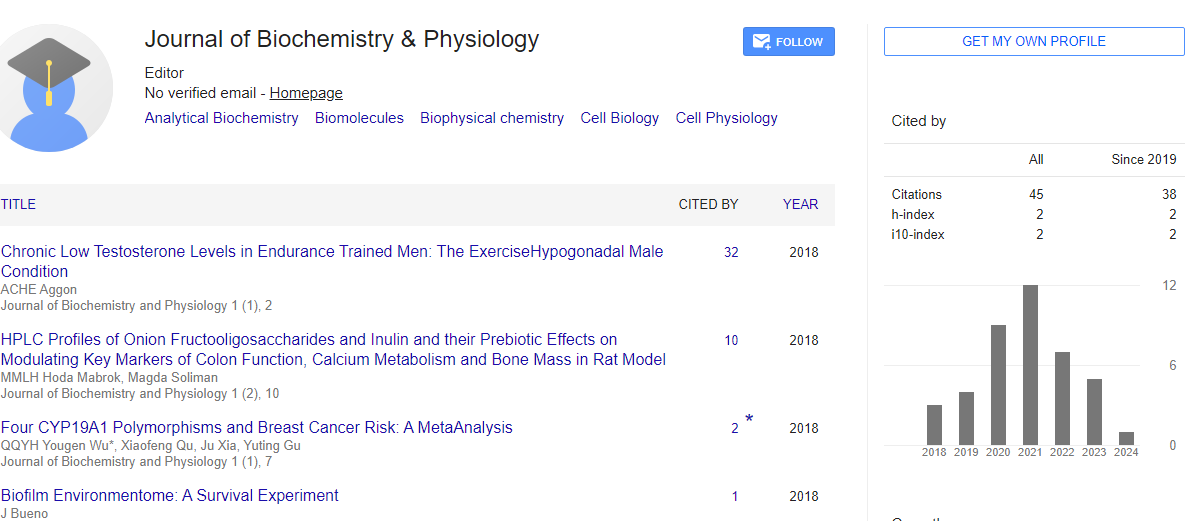Commentary, J Biochem Physiol Vol: 6 Issue: 3
Single-Molecule Studies of DNA Repair Mechanisms: Insights into Genome Stability
Chukwuemeka Okolie*
1Department of Biochemistry Section, National Institute of Neurological Disorders and Stroke, NIH, Bethesda, USA
*Corresponding Author: Okolie C,
Department of Biochemistry Section,
National Institute of Neurological Disorders and Stroke, NIH, Bethesda, USA
E-mail: linoricharg@nds.edu
Received date: 22 August, 2023, Manuscript No. JBPY-23-117707;
Editor assigned date: 24 August, 2023, Pre QC No. JBPY-23-117707 (PQ);
Reviewed date: 13 September, 2023, QC No. JBPY-23-117707;
Revised date: 21 September, 2023, Manuscript No: JBPY-23-117707 (R);
Published date: 28 September, 2023, DOI: 10. 4172/jbpy.1000144
Citation: Okolie C (2023) Single-Molecule Studies of DNA Repair Mechanisms: Insights into Genome Stability. J Biochem Physiol 6:3.
Description
DNA, the genetic blueprint of life, is constantly under assault from various sources, including radiation, chemical damage, and spontaneous errors in replication. To maintain the integrity of our genetic code, organisms have evolved complex DNA repair mechanisms. These repair processes are essential for genome stability, and understanding how they work at the molecular level is a key focus of biophysical chemistry. Single-molecule studies in this field have provided profound insights into the intricacies of DNA repair mechanisms and their role in preserving genome stability. Genome stability is critical for the survival and proper functioning of all living organisms. Genetic mutations can lead to a wide range of diseases, including cancer. When DNA damage occurs, cells must act quickly and efficiently to repair it. This is where DNA repair mechanisms come into play. These mechanisms are like the cellular repair crew that fixes the damaged sections of DNA to ensure that genetic information is faithfully transmitted to the next generation of cells. However, understanding the intricacies of these repair mechanisms is no small feat, given the size and complexity of DNA.
Traditional biochemical and biophysical techniques often involve studying bulk samples of molecules, which can provide valuable insights into DNA repair processes. However, these methods can miss important details and average out individual variations in the behavior of DNA and repair proteins. Single-molecule studies have revolutionized our ability to delve into the dynamics of DNA repair at the molecular level. Single-molecule studies involve tracking and manipulating individual molecules in real-time. By observing a single DNA molecule or a single repair protein, researchers can capture the nuances of repair processes that would be concealed in ensemble experiments. This approach offers several key advantages:
Single-molecule studies reveal the heterogeneity in repair processes. They allow researchers to observe how different repair proteins may interact with the same DNA lesion in distinct ways. This diversity can be crucial for understanding how the repair process adapts to different types of damage. By directly observing individual repair events, researchers can measure the precise kinetics of repair processes. This includes the rates at which repair proteins locate and bind to damaged DNA, as well as the efficiency of the repair itself.
Single-molecule studies can help uncover the detailed mechanisms behind repair processes. For example, they can reveal how repair proteins undergo conformational changes during the repair process or how DNA unwinds and reseals during base excision repair. One prominent area of research in single-molecule studies of DNA repair mechanisms is Base Excision Repair (BER). BER is a fundamental repair pathway that addresses small, non-helix-distorting DNA lesions, such as damaged bases or abasic sites. Understanding BER at the single-molecule level provides key insights into the dynamics of this process.
In a typical BER process, a DNA glycosylase enzyme recognizes and removes a damaged base. This creates an abasic site in the DNA strand. Subsequent steps involve the recruitment of other repair proteins, DNA unwinding, strand cleavage, and the insertion of a new base. Single-molecule studies have offered fascinating insights into this process: Using fluorescent labeling techniques, researchers can track individual repair proteins as they scan DNA for lesions. This has revealed that the search process is highly dynamic, with frequent dissociation and rebinding of repair proteins until the lesion is located. Single-molecule studies have shown that DNA is not a static molecule during repair. It undergoes structural changes, including bending and unwinding, which are crucial for facilitating repair protein binding and lesion recognition. Observing the repair process in real time has allowed researchers to uncover the coordination and timing of individual repair steps. For example, they can see how DNA cleavage is tightly regulated to ensure the fidelity of the repair process.
While BER has been a prominent focus, single-molecule studies are also shedding light on other DNA repair pathways, such as Nucleotide Excision Repair (NER) and mismatch repair. These studies have the potential to provide a comprehensive view of how various repair mechanisms contribute to genome stability. As the field of singlemolecule studies in DNA repair continues to advance, several challenges and exciting directions emerge: High-Resolution Imaging: Developing higher-resolution imaging techniques will allow researchers to visualize the repair process at even finer detail, including the movement and conformational changes of individual atoms. Multiplexing: The ability to simultaneously track multiple repair proteins and DNA molecules will provide a more comprehensive understanding of repair pathway interactions.
In vivo studies: Extending single-molecule studies to living cells will provide insights into how repair mechanisms operate within the complex environment of the cell nucleus.
Clinical applications: Insights gained from single-molecule studies can inform the development of new therapeutic strategies, such as enhancing the efficiency of DNA repair in cancer treatment.
In conclusion, single-molecule studies of DNA repair mechanisms are unveiling the intricate choreography of molecular events that safeguard genome stability. These studies not only enhance our fundamental understanding of DNA repair but also hold promise for applications in biomedicine. As technology and methodologies continue to advance, we can look forward to even deeper insights into the mechanisms that underpin the preservation of our genetic heritage.
 Spanish
Spanish  Chinese
Chinese  Russian
Russian  German
German  French
French  Japanese
Japanese  Portuguese
Portuguese  Hindi
Hindi 